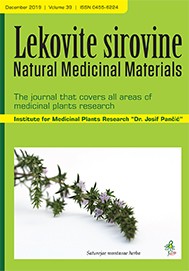Faculty of Technology and Metallurgy, University of Belgrade , Belgrade , Serbia
Department of Food Science and Technology, Biotechnical Faculty, University of Ljubljana , Ljubljana , Slovenia
Faculty of Technology and Metallurgy, University of Belgrade , Belgrade , Serbia
Institute for Medicinal Plant Research “Dr Josif Pančić” , Belgrade , Serbia
Institute for Medicinal Plant Research “Dr Josif Pančić” , Belgrade , Serbia
Faculty of Technology and Metallurgy, University of Belgrade , Belgrade , Serbia
The aim of the present study was the optimization of the extraction conditions (particle size, solid-to-solvent ratio, extraction time and procedure) via total polyphenol content and radical scavenging activity, using wild thyme as a natural source of polyphenols. According to the total polyphenols yield, particle size, solvent-to-solid ratio and extraction technique have shown statistically significant influence, whereas the exposure time has not been relevant factor. In all three extraction procedures (maceration, heat- and ultrasound-assisted extraction), the highest polyphenols yield was reached using the smallest plant particles and the highest solvent-to-solid ratio. Moreover, polyphenols content was significantly better after ultrasound-assisted extraction, in comparison to the extraction at room and high temperature. According to the antioxidant recovery, the influence of different extraction parameters varied depending on the applied antioxidant tests and extraction procedures. 2,2'-azino-bis(3-ethylbenzothiazoline-6-sulphonic acid) ˗ ABTS radical scavenging capacity of extracts followed the next trend: maceration and ultrasound-assisted extraction > heat-assisted extraction, while in 2,2-diphenyl-1-picrylhydrazyl ˗ DPPH neutralization: ultrasound-assisted extraction > heat-assisted extraction >> maceration. The study represents an important step in formulation of antioxidants-rich extracts with potential use in food, pharmaceutical and cosmetic industry.
This is an open access article distributed under the Creative Commons Attribution License which permits unrestricted use, distribution, and reproduction in any medium, provided the original work is properly cited.

The statements, opinions and data contained in the journal are solely those of the individual authors and contributors and not of the publisher and the editor(s). We stay neutral with regard to jurisdictional claims in published maps and institutional affiliations.